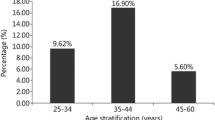Abstract
The prevalence of serological parameters indicative of infection with hepatitis A, B and C was determined using sera collected from representative population samples in the former East German (new) federal states and the West German (old) federal states during the German National Health and Examination Survey in 1998. Sera were tested for antibodies to hepatitis A virus (HAV), to hepatitis B core antigen (HBc) and to hepatitis B surface antigen (HBsAg), hepatitis C Virus (HCV), as well as for the presence of HBsAg and HCV-RNA. The mean weighted prevalence of anti-HAV was 46.5% (95% CI: 45.3–47.7) and increased markedly with age. The mean weighted prevalence of past infection with hepatitis B was 7.7% (95% CI: 7.0–8.4) in the old federal states and 4.3% (95% CI: 3.2–5.3) in the new federal states, corresponding to an overall prevalence of 7.0% (95% CI: 6.4–7.6). The mean weighted prevalence of HBsAg carriage was 0.6% (95% CI: 0.4–0.8), while the prevalence of HCV antibodies was 0.4% (95% CI: 0.2–0.5).
Similar content being viewed by others
References
Robinson WS. Hepatitis B virus and hepatitis D virus. In: Mandell GL, Bennett JE, Dolin R (eds), Principles and Practice of Infectious Diseases, Philadelphia: Churchill Livingstone, 1995; 1406–1439.
Lemon SM, Brown EA. Hepatitis C virus. In: Mandell GL, Bennett JE, Dolin R (eds), Principles and Practice of Infectious Diseases, Philadelphia: Churchill Livingstone, 1995; 1474–1486.
Robert Koch-Institut. Zur Situation bei wichtigen Infektionskrankheiten imJahr 1999. Teil 2: Virushepatitiden. Epidemiologisches Bulletin 2000; 28: 223–227.
Bellach B-M, Knopf H, Thefeld W. Der Bundes-Gesundheitssurvey 1997–1998. Gesundheitswesen 1998; 60(Suppl 2): S59–S68.
Thefeld W, Stolzenberg H, Bellach B-M. DeBundes-Gesundheitssurvey: Response, Zusammensetzung der Teilnehmer und Non-Responder-Analyse. Gesundheitswesen 1999; 61(Suppl 2): S57–S61.
Abb J. Praevalenz von Hepatitis-A-Virus-Antikoerpern bei Krankenhauspersonal (Prevalence of hepatitis A virus antibodies in hospital personnel). Gesundheitswesen 1994; 56(7): 377–379.
Hofmann F, Wehrle G, Berthold H, Koster D. Hepatitis A as an occupational hazard. Vaccine 1992; 10(Suppl 1): S82–S84.
Frö lich J, Zeller I. Hepatitis-A-Infektionsrisiko bei den Mitarbeitern einer grossen Kla¨ ranlagenbetreibergenbossenschaft (Risk of hepatitis A infection in persons working in a large-scale sewage plant co-operative). Arbeitsmedizin Sozialmedizin Praventivmedizin 1993; 28(11): 503–505.
Nothdurft HD, Loescher T. Folgen importierter Tropenkrankheiten in Deutschland. (Sequelae of imported tropical diseases in Germany). Versicherungsmedizin 1994; 46(4): 135–137.
Statistisches Bundesamt, (ed.) Statistisches Jahrbuch 1998, Wiesbaden: Metzler/Poeschel, 1998.
Statistisches Bundesamt, (ed.) Statistisches Jahrbuch 1993, Wiesbaden: Metzler/Poeschel, 1993.
Schenzle D, Dietz K, Froesner GG. Antibody against hepatitis A in seven European countries. II. Statistical analysis of cross-sectional surveys. AmJ Epidemiol 1979; 110(1): 70–76.
Studer S, Joller-Jemelka HI, Steffen R, Grob PJ. Prevalence of Hepatitis A antibodies in Swiss travellers. Eur J Epidemiol 1993; 9: 50–54.
Prodinger WM, Larcher C, Solder BM, Geissler D, Dierich MP. Hepatitis A in western Austria – the epidemiologic situation before the introduction of active immunisation. Infection 1994; 22: 53–55.
Beutels M, Van den Hoek JA, Vrancks R, Meheus A. The shift in prevalence of hepatitis A immunity in Flanders, Belgium. Acta Gastroenterol Belgica 1998; 61: 4–7.
Thefeld W, Seher C, Dortschy R. Hepatitis-B-Durchseuchung in der deutschen Bevölkerung. Vergleich zwischen neuen und alten Bundesländern. Bundesgesundheitsbl 1994; 9: 374–377.
Resina RA, Zawati FZ, Grandal DC. Prevalencia de marcodores serologicos del virus de la hepatitis B en poblacion extrahospitalaria de la ciudad de Vigo. Atencion Primaria 1992; 10: 1028–1029.
Hart G. Factors associated with Hepatitis B infection. Int J STD AIDS 1993; 4(2): 102–106.
Kiehl W. ZumAblauf der HIV-Epidemie und zur AIDS-Prävention in der ehemaligen DDR. AIDS Nachrichten 1990; 5: 14–18.
Joller-Jemelka H, Wicki A, Grob P. Detection of HBs antigen in ‘anti-HBc alone’ positive sera. J Hepatol 1994; 21: 269–272.
Neifer S, Molz B, Sucker U, Kreuzpaintner E, Weinberger K, Jilg W. Hoher Prozentsatz isoliert anti-HBcpositiver Personen unter Strafgefangenen. Gesundheitswesen 1997; 59: 409–412.
Palitzsch KD, Hottentraeger B, Schlottmann K, et al. Prevalence of antibodies against hepatitis C virus in the adult German population. Eur J Gastroenterol Hepatol 1999; 11(11): 1215–1220.
Christensen B, Boettiger M, Grillner L. The prevalence of hepatitis B in Sweden: A statistical serosurvey of 3381 Swedish inhabitants. Epidemiol Infect 1997; 119(2): 221–225.
García-Fulgueiras A, Tormao MJ, Rodriguez T, Perez-Flores D, Chirlaque D, Navarro C. Prevalence of Hepatitis B and C markers in the south-east of Spain: An unlinked community-based serosurvey of 2203 adults. Scand J Infect Dis 1996; 28(1): 17–20.
Stark K, Schreier E, Mueller R, Wirth D, Driesel G, Bienzle U. Prevalence and determinants of anti-HCV seropositivity and of HCV genotype among intravenous drug users in Berlin. Scandinavian J Infect Dis 1995; 27(4): 331–337.
Koerner K, Cardoso M, Dengler T, Kerowgan M, Kubanek B. Estimated risk of transmission of hepatitis C virus by blood transfusion. Vox Sang 1998; 74(4): 213–216.
Hillemanns P, Langenegger P, Langer BCA, Knitza R, Hasbargen U, Hepp H. Prävalenz und Verlauf der Hepatitis-C-Virusinfektion in der Schwangerschaft. Z Geburtsh Neonatol 1998; 202: 127–130.
Weber B, Rabenau H, Berger A, et al. Seroprevalence of HCV, HAV, HDV, HCMV and HIV in high risk groups /Frankfurt a.M. Germany. Zbl Bakt 1995; 282: 102–110.
Author information
Authors and Affiliations
Rights and permissions
About this article
Cite this article
Thierfelder, W., Hellenbrand, W., Meisel, H. et al. Prevalence of markers for hepatitis A, B and C in the German population. Results of the German National Health Interview and Examination Survey 1998. Eur J Epidemiol 17, 429–435 (2001). https://doi.org/10.1023/A:1013792013184
Issue Date:
DOI: https://doi.org/10.1023/A:1013792013184




